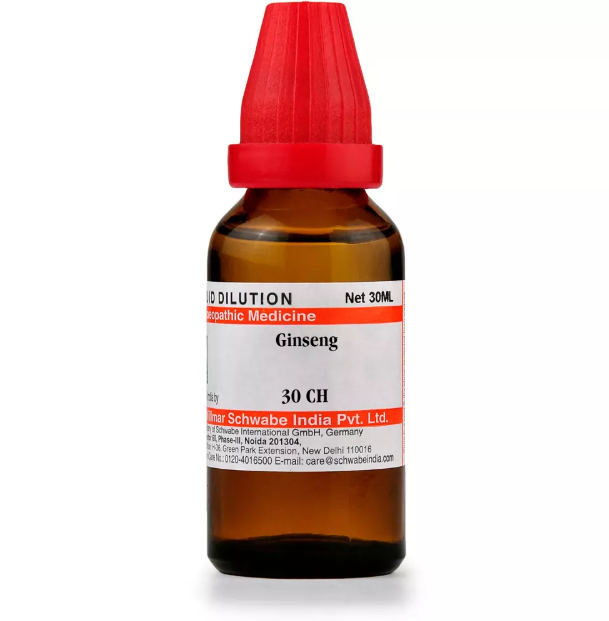GINSENG QUINQUEFOLIUM Q, 6C, 12C, 30C, 200C, 1M, 10M USES AND SYMPTOMS
 GINSENG QUINQUEFOLIUM
GINSENG QUINQUEFOLIUM
(Aralia Quinquefolia, Wild Ginseng, Panax)
Gins.
Acts as a stimulant for secretory glands, especially salivary, and affects the lower spinal cord. Useful for lumbago, sciatica, rheumatism, paralytic weakness, hiccough, and itching pimples on the neck and chest.
Head: Vertigo with gray spots before the eyes, migraines, occipital headaches.
Eyes: Difficulty opening eyelids, double vision.
Throat: Tonsillitis similar to Bell., particularly in dark-complexioned individuals.
Abdomen: Tense, painful, with rumbling and pain on the right side. Loud gurgling in the ileo-caecal region, perityphlitis.
Male: Rheumatic pains post-emissions, weakness of genital organs, pleasurable tickling at the urethra’s end, sexual excitement, pressure in testicles.
Extremities: Hands feel swollen and skin tight. Coldness of back and spine, bruised pain in the lumbosacral region and thighs, nocturnal pain in the right lower limb extending to toes, burning fingertips, eruptions on upper inner thighs, stiff joints, heaviness in lower limbs, crackling joints, stiff back.
Relationship: Compare with Aral., Coca. Hed.-Ivy (antidotes mental depression and skin irritation with Gunpowder).
Dose: Tincture to third potency.
SYMPTOMS OF GINSENG QUINQUEFOLIUM
Head:
Vertigo with gray spots before the eyes.
Migraines.
Occipital headaches.
Eyes:
Difficulty opening eyelids.
Double vision.
Throat:
Tonsillitis similar to Bell., particularly in dark-complexioned individuals.
Abdomen:
Tense and painful.
Rumbling and pain on the right side.
Loud gurgling in the ileo-caecal region.
Perityphlitis.
Male:
Rheumatic pains post-emissions.
Weakness of genital organs.
Pleasurable tickling at the urethra’s end.
Sexual excitement.
Pressure in testicles.
Extremities:
Hands feel swollen and skin tight.
Coldness of back and spine.
Bruised pain in the lumbosacral region and thighs.
Nocturnal pain in the right lower limb extending to toes.
Burning fingertips.
Eruptions on upper inner thighs.
Stiff joints.
Heaviness in lower limbs.
Crackling joints.
Stiff back.
selection of the potency
Individualization:
- Homeopathy is based on the principle of treating the individual, not just the disease. The unique symptoms and characteristics of the person are crucial in determining the most suitable potency.
Intensity of Symptoms:
- The intensity of the symptoms guides the choice of potency. If the symptoms are intense and acute, a lower potency (e.g., 6C, 30C) might be considered. For chronic conditions with less intensity, higher potencies (e.g., 200C, 1M) may be appropriate.
Sensitivity of the Patient:
- Some individuals are more sensitive to homeopathic remedies, while others may require higher potencies. The practitioner considers the patient’s sensitivity when selecting the potency.
Acute vs. Chronic Conditions:
- Lower potencies are often used for acute conditions, while higher potencies may be considered for chronic or long-standing issues.
Previous Response to Potencies:
- The patient’s response to previous homeopathic treatments helps guide the choice of potency. If a particular potency has been effective in the past, it may be repeated or adjusted as needed.
Vital Force and Susceptibility:
- Homeopathy views illness as a disturbance in the vital force. The practitioner assesses the patient’s overall vitality and susceptibility to determine the appropriate potency.
Aggravation or Amelioration:
- The direction of the symptom response (aggravation or amelioration) after taking a remedy can influence the choice of potency.
Miasmatic Considerations:
- In classical homeopathy, the concept of miasms (inherited disease tendencies) is considered. The practitioner take this into account when selecting the potency.
Practitioner Experience:
- The experience and preference of the homeopathic practitioner play a role. Some practitioners may have success with certain potencies based on their clinical experience.
SAFETY INFORMATION
- Do not exceed the recommended dose by physician
- Keep out of the reach of children
- Store in a cool dry place away from direct sunlight
- Maintain half an hour gap between food/drink/any other medicines and homoeopathic medicine
- Avoid any strong smell in the mouth while taking medicine e.g. camphor, garlic, onion, coffee, hing
Medicine images use for reference only selection of homeopathic medicine depends on the individual’s specific symptoms and overall constitution. Moreover, homeopathy is a holistic system of medicine that treats the individual as a whole. In addition to addressing the physical symptoms, it takes into account the emotional and mental state of the person. Consequently, it’s crucial to consult with a qualified homeopathic practitioner for personalized treatment.
The information provided on this website is intended solely for educational purposes. Always seek the advice of your physician or other qualified health provider.
